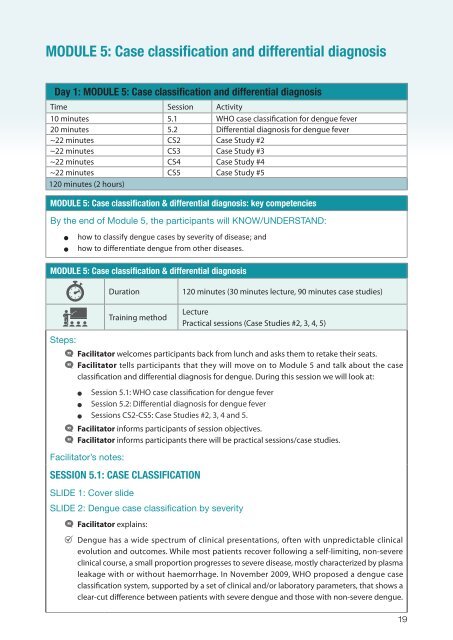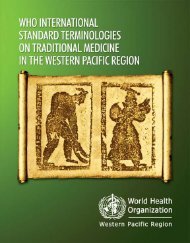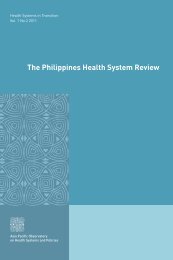Facilitator - WHO Western Pacific Region - World Health Organization
Facilitator - WHO Western Pacific Region - World Health Organization
Facilitator - WHO Western Pacific Region - World Health Organization
You also want an ePaper? Increase the reach of your titles
YUMPU automatically turns print PDFs into web optimized ePapers that Google loves.
MODULE 5: Case classification and differential diagnosis<br />
Day 1: MODULE 5: Case classification and differential diagnosis<br />
Time Session Activity<br />
10 minutes 5.1 <strong>WHO</strong> case classification for dengue fever<br />
20 minutes 5.2 Differential diagnosis for dengue fever<br />
~22 minutes CS2 Case Study #2<br />
~22 minutes CS3 Case Study #3<br />
~22 minutes CS4 Case Study #4<br />
~22 minutes CS5 Case Study #5<br />
120 minutes (2 hours)<br />
MODULE 5: Case classification & differential diagnosis: key competencies<br />
By the end of Module 5, the participants will KNOW/UNDERSTAND:<br />
OO<br />
OO<br />
how to classify dengue cases by severity of disease; and<br />
how to differentiate dengue from other diseases.<br />
MODULE 5: Case classification & differential diagnosis<br />
Duration<br />
120 minutes (30 minutes lecture, 90 minutes case studies)<br />
Steps:<br />
•<br />
Training method<br />
Lecture<br />
Practical sessions (Case Studies #2, 3, 4, 5)<br />
•<br />
•<strong>Facilitator</strong> welcomes participants back from lunch and asks them to retake their seats.<br />
•<strong>Facilitator</strong> tells participants that they will move on to Module 5 and talk about the case<br />
classification and differential diagnosis for dengue. During this session we will look at:<br />
OO<br />
Session 5.1: <strong>WHO</strong> case classification for dengue fever<br />
Session 5.2: Differential diagnosis for dengue fever<br />
•<br />
OO<br />
OO<br />
Sessions CS2-CS5: Case Studies #2, 3, 4 and 5.<br />
•<br />
•<strong>Facilitator</strong> informs participants of session objectives.<br />
•<strong>Facilitator</strong> informs participants there will be practical sessions/case studies.<br />
<strong>Facilitator</strong>’s notes:<br />
SESSION 5.1: CASE CLASSIFICATION<br />
SLIDE 1: Cover slide<br />
SLIDE 2: Dengue case classification by severity<br />
• •<strong>Facilitator</strong> explains:<br />
• •Dengue has a wide spectrum of clinical presentations, often with unpredictable clinical<br />
evolution and outcomes. While most patients recover following a self-limiting, non-severe<br />
clinical course, a small proportion progresses to severe disease, mostly characterized by plasma<br />
leakage with or without haemorrhage. In November 2009, <strong>WHO</strong> proposed a dengue case<br />
classification system, supported by a set of clinical and/or laboratory parameters, that shows a<br />
clear-cut difference between patients with severe dengue and those with non-severe dengue.<br />
19

















